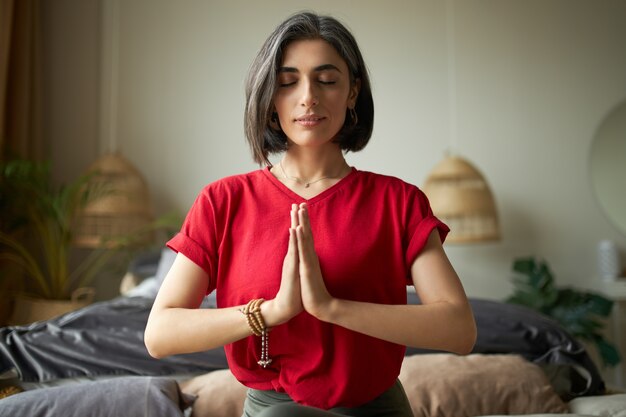Mindfulness and Meditation: Achieving Inner Peace
Discover the transformative power of mindfulness and meditation in achieving inner peace and emotional well-being. Learn practical techniques for cultivating mindfulness, reducing stress, and enhancing mental clarity in your daily life.

Introduction:

In today's fast-paced world, finding moments of calm and inner peace can feel like a rare luxury. However, with mindfulness and meditation, you can cultivate a sense of tranquility and emotional well-being that enriches every aspect of your life. In this guide, we'll explore the practice of mindfulness and meditation, and how it can help you achieve greater peace, clarity, and presence in your daily life.
Understanding Mindfulness: Cultivating Present-Moment Awareness
Mindfulness is the practice of paying deliberate attention to the present moment with openness, curiosity, and acceptance. By cultivating present-moment awareness, you can learn to observe your thoughts, feelings, and sensations without judgment or attachment. Mindfulness encourages you to fully engage with each moment of your life, fostering a deeper sense of connection, gratitude, and aliveness.
Benefits of Meditation: Nurturing Body, Mind, and Spirit
Meditation is a powerful tool for reducing stress, promoting relaxation, and enhancing overall well-being. Regular meditation practice has been shown to lower blood pressure, improve sleep quality, and boost immune function. Mentally, meditation can help calm the mind, reduce anxiety, and enhance mental clarity and focus. Spiritually, meditation can deepen your sense of connection to yourself, others, and the world around you, fostering a greater sense of peace, compassion, and equanimity.
Practicing Mindfulness Meditation: Techniques for Inner Peace
Mindfulness meditation involves bringing focused attention to the present moment, typically through the breath or bodily sensations. To practice mindfulness meditation, find a quiet space where you can sit comfortably with your eyes closed. Begin by focusing on your breath, noticing the sensation of each inhale and exhale as it moves through your body. When your mind wanders, gently guide your attention back to your breath, without judgment or frustration. Start with just a few minutes of meditation each day and gradually increase the duration as you become more comfortable with the practice.
Cultivating Mindfulness in Daily Life: Bringing Awareness to Everyday Moments
In addition to formal meditation practice, mindfulness can be cultivated in everyday life by bringing awareness to your daily activities and routines. Practice mindfulness while eating by savoring each bite, noticing the taste, texture, and aroma of your food. Practice mindfulness while walking by paying attention to the sensations of each step, feeling the ground beneath your feet and the movement of your body. By bringing mindfulness to everyday moments, you can infuse your life with greater presence, intention, and joy.
FAQs (Frequently Asked Questions):
What are some common misconceptions about mindfulness and meditation?
Common misconceptions about mindfulness and meditation include the idea that you need to clear your mind completely or achieve a state of perfect relaxation to practice effectively. In reality, mindfulness is about observing your thoughts and feelings without judgment, while meditation is about training the mind to focus and concentrate.
How can mindfulness and meditation benefit mental health?
Mindfulness and meditation have been shown to have numerous benefits for mental health, including reducing symptoms of anxiety, depression, and stress. These practices help calm the nervous system, promote relaxation, and enhance emotional regulation, leading to greater overall well-being and resilience.
How can I incorporate mindfulness into my busy schedule?
Incorporating mindfulness into a busy schedule can be as simple as taking a few moments each day to pause, breathe, and bring awareness to the present moment. Set aside dedicated time for formal meditation practice, and look for opportunities to practice mindfulness in everyday activities such as eating, walking, or driving.
Are there different types of meditation practices?
Yes, there are many different types of meditation practices, including mindfulness meditation, loving-kindness meditation, breath awareness meditation, and body scan meditation, among others. Each practice offers unique benefits and techniques for cultivating presence, awareness, and inner peace.
How can I stay motivated to maintain a regular meditation practice?
Staying motivated to maintain a regular meditation practice requires setting realistic goals, establishing a consistent routine, and finding enjoyment in the practice itself. Experiment with different meditation techniques to find what works best for you, and remember that consistency is key to experiencing the full benefits of meditation over time.
Can mindfulness and meditation be practiced by people of all ages and backgrounds?
Yes, mindfulness and meditation can be practiced by people of all ages and backgrounds, regardless of experience level or physical ability. These practices are accessible to everyone and can be adapted to suit individual preferences and needs.
Conclusion:
Mindfulness and meditation offer powerful tools for achieving inner peace, emotional well-being, and greater presence in your daily life. By cultivating present-moment awareness, reducing stress, and enhancing mental clarity, mindfulness and meditation can help you navigate life's challenges with greater ease, resilience, and grace. Whether you're new to the practice or a seasoned meditator, the transformative power of mindfulness and meditation awaits you, inviting you to embrace each moment with open arms and an open heart.